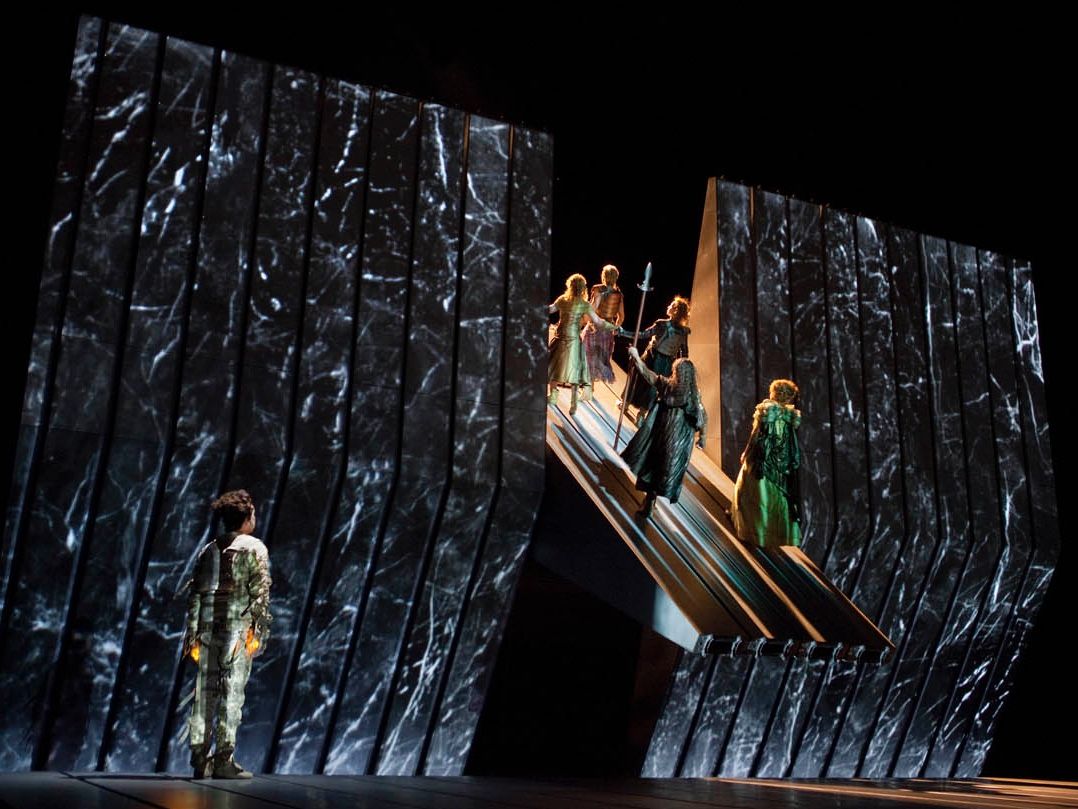VIEWPOINTS – Reassessing Lepage’s RING CYCLE for the Met, roughly at the halfway point
- By drediman
- March 30, 2019
- No Comments
Back in 2010, renowned French Canadian experimental theater director Robert Lepage embarked on staging Richard Wagner’s epic Ring Cycle – one of the towering achievements in Western Art – for the Metropolitan Opera, replacing a set of painstakingly literal (but much-loved) productions by Otto Schenk. Little did Mr. Lepage know that his productions would inspire “Spiderman”-level controversy. The central visual concept of the then new productions was a massive churning contraption simply known as the “Machine”, which was notorious for malfunctioning and injuring its performers. Mr. Lepage was also criticized for his not unfounded focus on technology, at the consequence of interpretive imagination.

A scene from Robert Lepage’s production of Richard Wagner’s “Das Rheingold” at the Metropolitan Opera.
Over the past two weeks, I’ve had the opportunity to start reassessing Mr. Lepage’s Ring Cycle. I’m roughly halfway through, having revisited Das Rheingold and Die Walküre. My thoughts? Well, I’m actually a defender of Mr. Lepage’s ambitious vision, although I admit that I still find some of its execution less than ideal. However, so far this time around, the Machine has luckily been behaving itself, with nary a technical glitch. It’s also noticeably less audibly creaky, which allows for optimal enjoyment of the music-making, which has been thrilling (more on that later). However there’s no getting around the fact that the shape-shifting set is a treacherous working environment for the singers, many of whom looked unsteady and unsure performing on it.
But what I find most compelling about the production is its quest to find a visual equivalent to Wagner’s astonishing music. In essence, Wagner’s leitmotif-driven score is an undulating, through-composed single unit. The Machine honors Wagner’s intent to create an immersive, organic work of art, allowing the fantastical story to move forward from scene to scene fluidly — as if dancing to the music — without clunky, distracting set changes. By and large, Mr. Lepage has accomplished this with technical mastery and a good amount of grace, even if some of the resulting static stage pictures, aided by high tech video projections, are a touch on the vague side.
As for the accusations of uninspired storytelling, I think they’re largely unfounded. Yes, many notable productions of the Ring Cycle in the past have forcefully turned the work’s elaborate story (involving gods, dwarves, sea maidens, valkyries, humans, giants, dragons, serpents, and so forth!) into metaphors for foundational elements of human civilization. I actually think the idea of performing the operas without the expectation of drawing direct parallels to the current human condition is refreshing. Indeed, Lepage’s Ring is a blockbuster fairytale – nothing more, nothing less. In this respect, his work is an unlikely but natural heir to Mr. Schenk’s preceding version.

A scene from Robert Lepage’s production of Richard Wagner’s “Die Walküre” at the Metropolitan Opera.
As for the performances, they’ve been mostly stellar, particularly the current cast of Die Walküre. Soprano Christine Georke is the headliner here, unveiling her Brunhilde to New York opera lovers, and she doesn’t disappoint, producing a beautifully nuanced performance and handily taking on the role’s considerable vocal challenges with ease and expressive color. Other standouts include the incestuous twins Siegmund and Sieglinde, played heroically by tenor Stuart Skelton and soprano Eva-Maria Westbroek, respectively. Although I wanted more gravitas from bass-baritone Greer Grimsley in the central role of the conflicted god Wotan, his performance solidly did the job. As Wotan’s wife Fricka, powerful mezzo-soprano was magnificent, as was Günther Groissböck as both the villainous Hunding and the giant Fasolt in Das Rheingold. In that previous installment, bass-baritone Tomasz Konieczny stole the show with an intense, fully-formed portrayal of the evil dwarf Alberich.
The music-making in the pit by the mighty Met Orchestra was also sensational, as led by maestro Philippe Jordan, whose account of Wagner’s masterpiece was propulsive and crystal clear. It certainly made for exciting storytelling, filling in any residual blandness left behind by Mr. Lepage’s staging.
RECOMMENDED
RING CYCLE: DAS RHEINGOLD & DIE WALKÜRE
Opera
The Metropolitan Opera
Das Rheingold is 2 hours, 30 minutes (without an intermission); Die Walküre is 5 hours (with two intermissions)
In repertory

 Copyright © 2025
Copyright © 2025
Leave a Reply